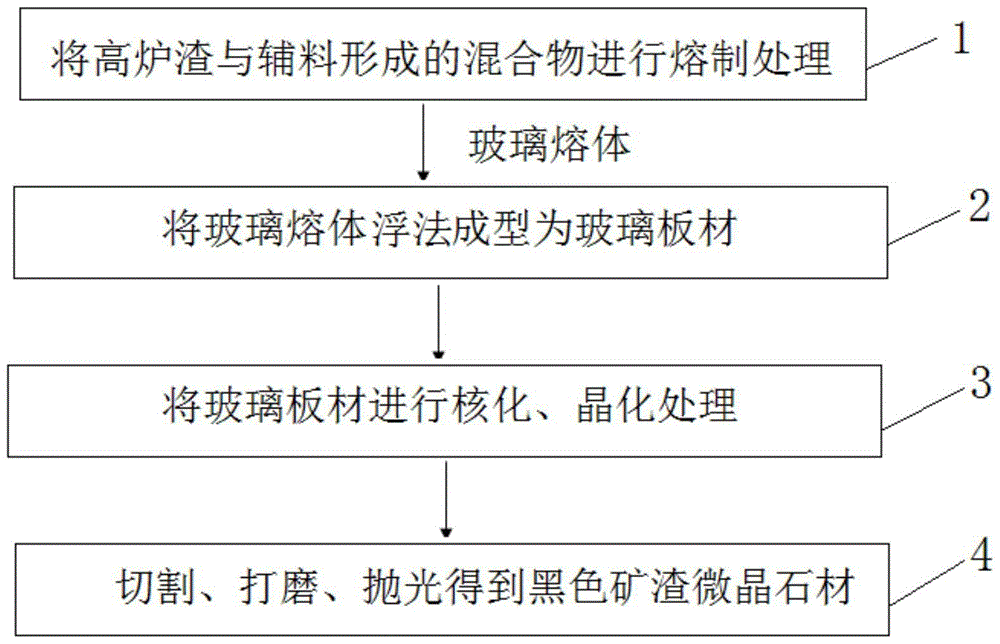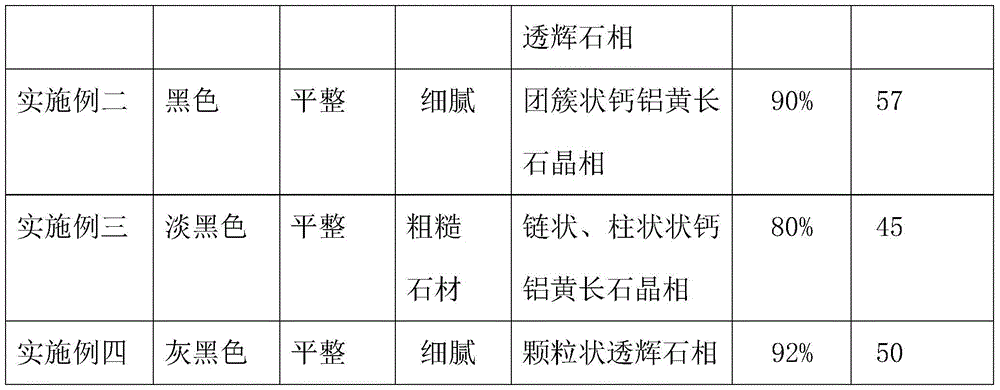A kind of black slag microcrystalline stone and preparation method thereof
A slag and microcrystalline technology, applied in the field of black slag microcrystalline stone and its preparation, can solve the problem that microcrystalline stone is difficult to add a large proportion of blast furnace slag, and the flatness and surface quality of microcrystalline stone are poor, and it is difficult to be recognized by the market and promotion issues, to achieve the effect of breaking through manufacturing bottlenecks, good surface quality, and high flatness
- Summary
- Abstract
- Description
- Claims
- Application Information
AI Technical Summary
Problems solved by technology
Method used
Image
Examples
Embodiment 1
[0066] 1. Mix 60 parts of blast furnace slag, 27 parts of quartz sand, 6 parts of soda ash, 2 parts of sodium fluorosilicate, 4 parts of chromite, 0.6 part of titanium dioxide, and 0.4 part of coal powder to obtain a glass batch.
[0067] 2. Slowly send the above-mentioned batch materials into the glass furnace, control the melting temperature to 1500°C, and obtain usable tempered glass after 4-6 hours of melting, 2-3 hours of homogenization and 1-2 hours of clarification melt.
[0068] In this step, the chemical composition of the glass melt is detected, so that the composition of the glass melt is: SiO 2 52.3%, CaO 22.9%, Al 2 o 3 9.39%, MgO 4.16%, Fe 2 o 3 2.15%, Cr 2 o 3 2.5%, Na 2 O is 4.23%, F is 1.43%, TiO 2 0.62%, others: 0.32%. The upper limit of the crystallization temperature of the glass melt is 1065°C, the viscosity of the glass melt is 650Pa·S at a temperature of 1150°C, and 12589Pa·S at a temperature of 950°C.
[0069] 3. The above-mentioned glass melt...
Embodiment 2
[0076] 1. First introduce 78 parts of blast furnace molten slag into the glass melting furnace; then mix 10 parts of quartz sand, 6 parts of soda ash, 2 parts of sodium fluorosilicate, 3 parts of chromite, 0.6 parts of titanium dioxide and 0.4 parts of coal powder Then it is slowly sent into the glass melting furnace.
[0077] 2. Control the melting temperature to 1480°C. After 4-6 hours of melting, 2-3 hours of stirring and homogenization, and 1-2 hours of clarification, a usable tempered glass melt can be obtained.
[0078] In this step, the chemical composition of the glass melt is detected, so that the composition of the glass melt is: SiO 2 41.85%, CaO 29.9%, Al 2 o 3 12.3%, MgO 5.4%, Fe 2 o 3 1.9%, Cr 2 o 3 1.9%, Na 2 O is 4.3%, F is 1.26%, TiO 2 0.74% for others and 0.45% for others. The upper limit of the crystallization temperature of the glass melt is 1050°C, the glass melt viscosity is 500 Pa·S at a temperature of 1150°C, and the glass melt viscosity is 158...
Embodiment 3
[0086]1. Mix 65 parts of blast furnace water-quenched slag, 26 parts of quartz sand, 7 parts of soda ash, 2 parts of sodium fluorosilicate, and 3.4 parts of chromite to obtain a glass batch.
[0087] 2. Slowly send the above-mentioned batch materials into the glass furnace, control the melting temperature to 1500°C, and obtain usable tempered glass after 4-6 hours of melting, 2-3 hours of homogenization and 1-2 hours of clarification melt.
[0088] In this step, the chemical composition of the glass melt is detected, so that the composition of the glass melt is: SiO 2 50.8%, CaO 24.8%, Al 2 o 3 9.8%, MgO is 4.86%, Fe 2 o 3 1.87%, Cr 2 o 3 2.2%, Na 2 O is 4.23%, F is 1.30% Other: 0.14%. The upper limit of the crystallization temperature of the glass melt is 1060°C, the viscosity of the glass melt is 640Pa·S at a temperature of 1150°C, and 12889Pa·S at a temperature of 950°C.
[0089] 3. The above-mentioned glass melt enters the feeding channel through the liquid flow h...
PUM
| Property | Measurement | Unit |
|---|---|---|
| crystallization temperature | aaaaa | aaaaa |
| particle size | aaaaa | aaaaa |
| crystallization temperature | aaaaa | aaaaa |
Abstract
Description
Claims
Application Information
 Login to View More
Login to View More - R&D
- Intellectual Property
- Life Sciences
- Materials
- Tech Scout
- Unparalleled Data Quality
- Higher Quality Content
- 60% Fewer Hallucinations
Browse by: Latest US Patents, China's latest patents, Technical Efficacy Thesaurus, Application Domain, Technology Topic, Popular Technical Reports.
© 2025 PatSnap. All rights reserved.Legal|Privacy policy|Modern Slavery Act Transparency Statement|Sitemap|About US| Contact US: help@patsnap.com



